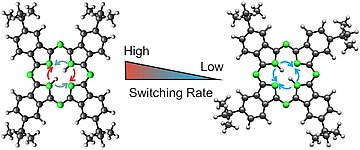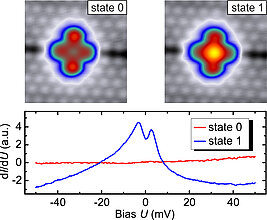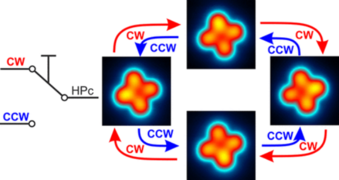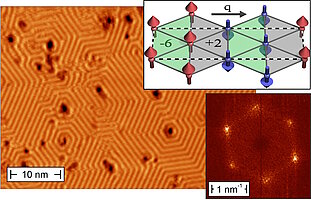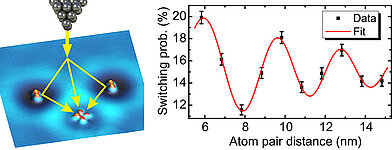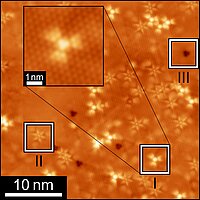2018
Image & Results Gallery (2018 archive)
How to decouple molecules from surfaces
Nov. 29, 2018
Organic chemistry allows for a basically infinite number of modifications of molecular structures. For example, substituents added to a molecule can lead to either a stronger or a weaker coupling to the substrate. We performed a comparative study of tetra-tert-butyl phthalocyanine (ttbPc) isomers on a Ag(111) surface by means of low-temperature scanning tunneling microscopy to analyze the influence of substituents on the tautomerization, a proton transfer reaction, in single molecules. By comparison with other well-studied molecules we find a decoupling of ttbPc from the surface. We find significant differences between the four ttbPc isomers which naturally exist due to different bonding positions of the tert-butyl groups on the macrocycle. The result has been published in the Journal of Physical Chemistry C.
A switchabe molecular magnet
Nov. 8, 2018
The control of the charge- and spin state of single molecules is key for the design of molecular electronic and spintronic devices. For switching the spin or magnetic state of molecules two principles have been used in the past: (1) atoms or small molecules were added to and removed from the host molecule or (2) by modifying the shape of molecules which can exist in more than one configuration. The realization of both methods is rather difficult. In cooperation with theorists around Prof. Giorgio Sangiovanni (TP I), in a recent publication our group presented an alternative way to achieve multiple and reversibly switchable spin states in a single molecules. These results show that a bistable molecular state can be achieved by positioning single manganese phthalocyanine (MnPc) molecule on top of an antiphase boundary of the (3×3)-reconstructed surface alloy of bismuth on Ag(111). In this environment we can switch single molecules between a high- and a low-spin state by using the electric field of a sharp STM tip. The result has been published in npj Quantum Materials.
How to induce chiral proton motion into achiral molecules
Aug. 18, 2018
Molecular machines rely on the directional motion of sub-molecular units, which is often achieved by built-in structural chiralities. In a recent scanning tunneling microscopy study, Jens Kügel and Markus Leisegang discovered that even achiral H2Pc and HPc molecules can perform chiral intra-molecular motion. The deposition onto a Ag(100) surface leads to an adsorption-geometry-induced chirality which is caused by a rotation of the molecules with respect to the high-symmetry directions of the substrate. As a result, tautomerization processes referentially occur in a clockwise or counterclockwise direction. In contrast to built-in structural chiralities that are fixed by the molecular structure, the direction of proton motion in HPc on Ag(100) can be inverted by a rotation of the molecule on the substrate. The result has been published in ACS Nano.
Novel magnetic structure discovered
May 14, 2018
By spin-polarized STM, a magnetically sensitive microscopy technique with atomic resolution capability, we could observe a novel theoretically predicted magnetic ground state, a so-called up-up-down-down (↑↑↓↓) spin structure. As shown in the STM image above, this exotic magnetic structure exists in three orientational domains in a mono-layer Fe on Rh(111). Calculations performed at the Forschungszentrum Jülich reveal that this magnetic structure is caused by a beyond-Heisenberg interaction. The result has been published in Phys. Rev. Lett.
MONA - a new technique to measure nanoscale transport
Feb 27, 2018
The electrical resistance of materials or devices is often measured by the 4-point probe method to eliminate lead and contact resistance issues. In the recent decade, miniaturized versions, so-called nanoprobes, have been developed where four sharp tips are individually positioned by piezo-actuators and simultaneously imaged with a scanning electron microscope (see here for an example). However, the finite tip sharpness usually limits the minimal distance to about 100 nm.
In a new publication, which was also highlighted in Nature Nanotechnology, we describe the development of a novel method which enables to detect how charged quasiparticles propagate on length scales down to a few nm by remotely triggering the tautomerization of a single molecule with a scanning tunneling microscope (STM). In analogy to the 4-point nanoprobe we coined it “molecular nanoprobe” (MONA). In combination with atom-by-atom-engineered interferometers, MONA allows to unravel the quantum-mechanical wave nature of hot electrons. Two interferometers can even be combined to build an energy-dependent selector, which allows it to selectively switch one out of two molecules without changing the position of the STM tip. The MONA technique may, in the future, serve as a method to map the charge density distribution around an arbitrary quasiparticle injection point. more
How to dope topological insulators towards ferromagnetism
Feb 13, 2018
In a recent highly collaborative publication in Phys. Rev. B with colleagues from Sweden, Italy, Russia, France, and Spain, we report on a systematic investigation of the transition metal-doped topological insulator Sb2Te3. By combining density functional theory with complementary experimental techniques, i.e., STM, resonant photoemission, and x-ray magnetic circular dichroism, we achieved a detailed characterization of the electronic and magnetic properties. Our results provide general guidelines how to realize a robust QAHE by doping Sb2Te3 towards a ferromagnetic state.





